
Syntactic criteria
 المؤلف:
Jim Miller
المؤلف:
Jim Miller
 المصدر:
An Introduction to English Syntax
المصدر:
An Introduction to English Syntax
 الجزء والصفحة:
40-4
الجزء والصفحة:
40-4
 29-1-2022
29-1-2022
 4120
4120
Syntactic criteria
The syntactic criteria for word classes are based on what words a given word occurs with and the types of phrase in which a given word occurs. Syntactic criteria are the most important. They are important for English with its relative poverty of morpho-syntactic criteria, and they are crucial for the analysis of word classes in general because there are languages such as Mandarin Chinese which have practically no inflectional suffixes (such as plural endings); in contrast, all languages have syntax.
The recognition of syntactic criteria as central is a major step forward, but the application of these criteria is not straightforward. Consider the English words that are called nouns. They all have several properties in common, namely they can occur in various positions relative to the verb in a clause. Examples (4a–c) are instances of the [NON-COPULA, ACTIVE, DECLARATIVE]

Dog occurs to the left of stole in (4a), to the right of chased in (4b), and to the right of saved in (4c) but separated from it by the intervening word for. Dog also occurs in a noun phrase and can be modified by a word such as the – The dog stole the turkey – or by an adjective – Hungry dogs stole the turkey – or by the and an adjective together – The hungry dogs stole the turkey.
All other nouns in English can occur to the left of the verb in an active declarative clause, but not all nouns combine with an article, or combine with articles in the same way as dog does. Dog stole the turkey is unacceptable (assuming Dog is not a proper name), whereas Ethel stole the turkey is not. The difficulty is that the class of English nouns is a very large class of words that do not all keep the same company (or, to use another metaphor, do not all behave in the same way). All nouns meet the criteria of occurring to the left of a verb in an active declarative clause, of occurring immediately to the right of a verb in an active declarative clause or of occurring to the right of a verb but preceded by a preposition. These are major criteria, but there are the minor criteria mentioned above, such as combining with an article, or being able to occur without an article, or not allowing a plural suffix (*Ethels). These split the class of nouns into subclasses.
A sufficiently detailed examination of the company kept by individual nouns would probably reveal that each noun has its own pattern of occurrence. Thanks to very large electronic bodies of data and the search power of computers, analysts are beginning to carry out such examinations and to find such individual patterns. For the purposes of analyzing syntax, however, it is not helpful to gather information about individual nouns and it is impossible to produce a useable analysis of English syntax (or the syntax of any other language) with, say, 20,000 word classes. To analyse and discuss the general syntactic structure of clauses and sentences, we need fairly general classes, and analysts try to keep to major criteria plus those minor criteria that lead to relatively large classes of words. For other purposes, such as compiling a dictionary, smaller classes are required, down to information about individual words.
A concept that is central to discussion of word classes, and indeed to any class of items, linguistic or non-linguistic, is that of the central and peripheral members of a class. Consider the adjective tall in the examples in (5).

There are two criteria labelled ‘d’ because some adjectives take the comparative suffix -er while others do not allow that suffix but require more. Some adjectives, like tall, meet all the criteria in (5) and are central or prototypical members of the class. Some adjectives fail to meet all the criteria.
Unique satisfies (5a–c), as in a unique building, This building is unique and a very unique building. (Publishers’ copy-editors might object to very unique, but the combination occurs regularly in speech and in informal writing and even in newspapers.) Unique does not combine with -er or more: *a uniquer building, *a more unique building. In the class of adjectives, unique is slightly less central than tall. Woollen meets even fewer criteria. A woollen cloak and This cloak is woollen are acceptable, but *a woollener cloak, *a more woollen cloak and *a very woollen cloak are not. Woollen is less central than unique, which in turn is less central than tall. Right at the edge of the class is asleep, which meets only one of the criteria in (5), namely (5b). The child is asleep is acceptable but not *the asleep child, *the very asleep child, *the more asleep child. On the other hand, asleep meets none of the criteria for nouns, verbs, prepositions or adverbs; it is a peripheral adjective.
 الاكثر قراءة في Syntax
الاكثر قراءة في Syntax
 اخر الاخبار
اخر الاخبار
اخبار العتبة العباسية المقدسة


